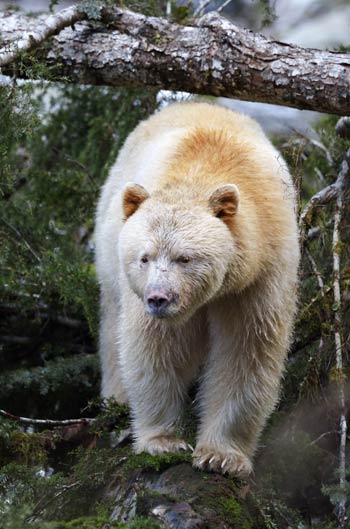它是一种黑熊,但却天生雪白毛皮。它生活在大熊雨林中,受到当地土著居民的高度保护。相比普通的黑熊,它是捕鱼能手。它皮毛变白是因为隐形基因突变,但科学家们至今也无法确定这种基因突变的起因。这种极为珍稀的动物被称为“白灵熊”,也叫“克莫德熊”。让我们跟随作者进入神秘幽暗的丛林,一起寻找这种精灵之熊吧!

By Bruce Barcott
经纬 选编 Wendy 译注
|
With a wildlife guide, I stepped on a journey to find one of the rarest creatures in the world—the spirit bear, a walking contradiction—a white black bear. Neither albino nor polar bear, the spirit bear (also known as the Kermode bear[1]) is a white variant of the North American black bear, and it’s found almost exclusively here in the Great Bear Rainforest. At 25,000 square miles—one and a half times as big as Switzerland—the region runs 250 miles down Canada’s western coast. It also consists of a vast network of mist-shrouded fjords, densely forested islands, and glacier-capped mountains. Grizzlies, black bears, wolves, wolverines, humpback whales, and orcas thrive along this coast. It’s a spooky[2], wild, mysterious place: there are wolves here that fish. Deer that swim. Western red cedar trees that have stood a thousand years. And a black bear that is white. At first we did not see any spirit bear. My guide Robinson scanned for movement. No bears. But then he spotted a tuft of white fur snagged on an alder branch. “They’re around here, for sure,” he said. He pointed to the chewed bark. “They like to stand and bite the tree just to say to other bears, I’m here using this river.” An hour passed. Robinson and I waited patiently on top of a moss-patched boulder. Then he heard a rustling in the bush. “There he is,” he said. A white bear stepped out of the tree cover onto a streamside rock. Set against the dark rain forest, the bear’s fur appears shabbily radiant. Not pure white, exactly. More like a vanilla-colored carpet in need of a steam cleaning. The bear swung its head from side to side, peering into an eddy for salmon. Before it can lunge for[3] one, a black bear suddenly comes out of the forest and runs the white bear off its perch—though “runs” might be a bit strong. Everything the bears do seems to unfold in slow motion, as if they’re trying to conserve every last calorie for the coming winter. The white bear lumbers[4] into a thicket and disappears. Robinson watches. He’s spent 15 years among the spirit bears. Still, he’s transfixed. “This particular white bear is very submissive,” he says. “Sometimes that gets to[5] me. I’m protective. I once saw an old white bear attacked by a younger black bear. I was about to jump in and pepper spray the black one. The instinct was strong in me. But then the white one reared up and threw him off.” Robinson smiles. Robinson isn’t alone. That same protective instinct runs strong throughout the Great Bear Rainforest. It’s one of the factors that have kept the spirit bear alive. “Our people never hunted the white bear,” said a native clan matriarch. Bear meat was rarely a main food, though they went after black bear in greater numbers when European merchants established the British Columbian fur trade in the late 18th century. Even in those days, taking a white bear was taboo, a tradition that has continued through many generations. “We never even spoke of the spirit bear at the dinner table,” she said. Scientists know how black bears are born white. They’re just not sure why. The phenomenon, known as Kermodism, is triggered by a recessive mutation at the MC1R gene, the same gene associated with red hair and fair skin in humans.[6] To be born white, a bear must inherit the mutation from both parents. The parents themselves don’t have to be white. They just need to carry the recessive mutation. So it’s not uncommon for white bears to be born to black parents. White fur happens in only one of every 40 to 100 black bears on the British Columbia mainland coast, but the trait is especially distinct on certain islands in the Great Bear Rainforest. For example, on Princess Royal Island, one in ten black bears is white, and on Gribbell Island, directly north of Princess Royal, it’s one in three. It’s unclear how the trait arose. One theory was the “glacial bear” hypothesis that the spirit bear represented a remnant adaptation from the last great ice age, which ended here 11,000 years ago. At that time most of modern-day British Columbia was still icebound, and a white coat may have offered camouflage. But the “glacial bear” theory raised a question: Why didn’t the white fur trait die out when the glaciers receded? Researchers have recently proved that the spirit bear’s white coat gives it an advantage when fishing. Although white and black bears tend to have the same success rate after dark, there is a difference during the daytime. White bears catch salmon in one-third of their attempts. Black individuals are successful only one-quarter of the time. “The salmon are less concerned about a white object as seen from below the surface,” a scientist speculates. That may answer part of the question about why the white-fur trait continues to flourish today. If salmon are a coastal bear’s primary fat and protein source, a successful female can feast on salmon to store more fat for winter, potentially increasing the number of cubs she can produce. As the rain continued to fall on Princess Royal Island, we watched the spirit bear feed on a bounty of salmon. When the pickings are good, bears can turn finicky. Some eat only the fish head. Others may slit the belly and suck out the eggs. Some are gluttons. We observed the scene for hours, until daylight faded from the sky. |
跟随一位野生动物向导,我踏上了寻找世界上最稀有的动物之一“白灵熊之旅”。它是一个活着的矛盾体:一种长着雪白皮毛的黑熊。白灵熊(也被称为“克莫德熊”)既不是白化病患者,也不是北极熊家族的成员。它是北美黑熊的一个白色变种,几乎全部都生活在大熊雨林中。大熊雨林覆盖面积达25,000 平方英里,是瑞士国土面积的1.5倍,它沿着加拿大西海岸延绵250英里。这片雨林覆盖了大片薄雾缭绕的峡湾、树木繁茂的岛屿和冰川盖顶的山脉。灰熊、黑熊、狼、狼獾、座头鲸和虎鲸在这片海岸繁衍生息。这是一个阴森原始的神秘之所:狼在这里捕鱼,鹿在这里游泳,这里的西部红雪松生长了千年之久,而黑熊也披上了白衣。 最先我们并没有看见白灵熊。我的向导鲁宾逊仔细搜寻了各种蛛丝马迹,都没有发现它们的踪迹。随后他发现了一撮白毛挂在一根桤木枝上。“它们就在附近,我敢肯定。”他指着被咬过的树皮说:“它们喜欢站起来啃树皮,以此来告诉其他同伴,这条河是我的地盘。”一小时过去了,我和鲁宾逊仍在一块布满苔藓的巨石上耐心地等待着。然后,他听到灌木丛中沙沙作响。他说:“就在那儿。” 一头白灵熊从树丛中走了出来,来到河边的一块石头上。在幽暗雨林背景的衬托下,它的毛发着微光。严格来说,并非纯白色,更像是一块需要溪水冲洗的香草色地毯。这头白灵熊把脑袋从一边甩到另一边,紧盯着涡流中的鲑鱼。正当它要扑入水中捉鱼时,一头黑熊突然从森林里窜了出来,把白灵熊从石头上冲了下来。不过,用“冲”这个词或许有些夸张。这两只熊的每一个动作就像是慢镜头般展现在眼前,它们好像是为了即将到来的寒冬而努力多保留最后的每一分热量。白灵熊慢吞吞地走进丛林,消失了。 鲁宾逊目睹了整个过程。他与白灵熊打交道已经有15个年头了,但依然是当场愣住了。“这头白灵熊太温顺了,”他说,“有时候我很担忧。我保护意识很强。有一次,我看到一头年迈的白灵熊受到一头年轻黑熊的攻击。我几乎就要冲过去,用胡椒粉喷雾赶走那只黑熊。我内心的这种本能意识很强。然而就在这时,那只白灵熊用后腿直立,击败了黑熊。”鲁宾逊微笑着。 并非鲁宾逊一人有这样的感觉。在整个大熊雨林地区,人们怀有强烈的保护白灵熊的本能意识,这也是白灵熊能够繁衍生息的一个原因。“我们从来不猎杀白灵熊,”当地一位女部落的族长如是说。当地人很少拿熊肉作主食。虽然在18世纪后期,欧洲商人在不列颠哥伦比亚省进行毛皮贸易时,当地原住民曾猎杀过大量的黑熊。但即便在那时,捕杀白灵熊也是一种禁忌,这是一个代代传承的传统。“我们甚至从未在餐桌上提起过白灵熊,”她说。 科学家知道黑熊如何生出白毛,但他们不能确定具体原因。这种现象被称为“克莫德现象”,是由黑素皮质素受体1基因的一种隐性突变引发所致。在人类身上,这种基因与红头发和白皮肤有关。小熊必须继承父母双方的变异基因,才能够天生白毛。而父母自己的皮毛并非一定是白色的,只需携带这种隐性突变基因即可,因此黑熊父母生出小白熊并不稀奇。 在不列颠哥伦比亚省大陆海岸,每40头到100头黑熊中,只有一头白毛熊出现。相比之下,这一现象在大熊雨林的部分岛屿上却尤为明显。例如,在大公主岛上,十头黑熊中便有一头是白灵熊;在大公主岛正北方的科里布岛上,这个比例更是高达三分之一。 这种遗传特征的起源仍旧是一个谜。有一种理论叫“冰川熊”假说:认为白灵熊代表了1.1万年前最后一个冰河时代残留下来的一种适应性变异。那时,如今的不列颠哥伦比亚省的绝大多数地区都被冰雪覆盖,白色的皮毛可能会提供很好的伪装。但“冰川熊”理论也提出了一个疑问:为什么这种白色毛皮的特征没有随着冰川的消退而消失? 研究者们最近证实,白灵熊的白色皮毛使其在捕鱼时更具优势。尽管白灵熊和黑熊在天黑后捕鱼的成功率差不多,但在白天却有所不同:白灵熊捕捉鲑鱼的成功率为三分之一,而黑熊此时的几率仅为四分之一。“鲑鱼从水面之下往上看时,对白色物体倒不大在意,”一位科学家推测说。这在一定程度上也解释了白色皮毛特征延续至今的原因。如果鲑鱼是生活在岸边的熊的主要脂肪和蛋白质来源,白灵母熊又能成功捕食鲑鱼,为冬季储存更多的脂肪,那么就可能提高其产崽量。 大公主岛上的雨仍下个不停,我们正在观看一头白灵熊大量地捕食鲑鱼。当河里鲑鱼数量充足时,熊就会变得很挑剔。有的只吃鱼头,有的则撕开鱼肚,只吸食里面的鱼籽,还有一些熊则狼吞虎咽。我们观察这一景象达几小时之久,直至日光从天幕中渐渐消逝。 (来源:英语学习杂志) |
|
Vocabulary: 1. Kermode bear: “克莫德熊”之名取自一位研究此物种的加拿大人弗兰西斯•克莫德(Francis Kermode)。 2. spooky: 阴森森的,怪异得使人害怕的。 3. lunge for: 猛冲,猛扑过去。 4. lumber: 笨重地行进,行动迟钝。 5. get to: 〈美俚〉使担心,使沮丧。 6. recessive mutation: 隐形基因突变;MC1R: 黑素皮质素受体1基因,是控制动物黑色素合成的重要基因。 |